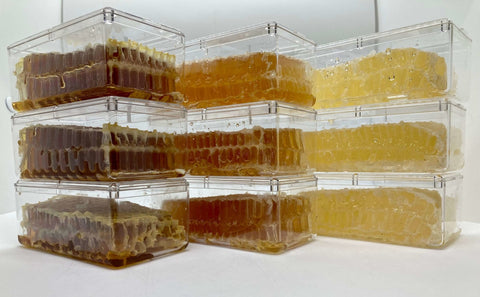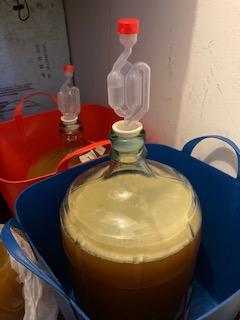A wild bee hive makes its own beeswax combs with a specific bee space between the combs to allow for the bees to access the hexagon cells to either store honey or make a brood nest in the form of eggs, larva and pupae. Until the mid 1800's beekeeping was more of a foraging profession where a hive in a tree was robbed or destroyed and the combs collected for food. Eventually bees were kept in straw skeps or log or clay hives, but the combs were still destroyed to remove a honey crop. The way they kept bees was to let the hive swarm first into a new skep or log before destroying the donor hive for honey collection. So prior to the mid 1800's most of the honey that was consumed as food by humans was in the form of edible beeswax combs.
A priest, Rev. Lorenzo Langstroth invented a hive that used removable wood frames of combs in 1851 and that allowed for the honey to be easily extracted by centrifugal force and the wood frame of beeswax combs reused. This invention made beekeeping and bee farming more viable and sustainable as the honey crop can be removed separately from the brood nest leaving the hive intact. Wooden frame beeswax combs are used for either the brood nest or surplus honey collection. Comb honey is also made in wooden frames but the wax starter sheet is much thinner and must be replaced every year as the comb is cut out not extracted from the frame and sold in pieces.

A colony of strong bees that fills a typical medium sized extracting super (box of combs) that can hold 34 pounds of honey, would consume another 8 pounds of honey while building new wax combs. So the benefits of reusable combs invented by Langstroth is significant. Comb honey frames must be cleaned each year and a thin starter sheet of beeswax installed. As the largest comb honey producer in Minnesota, we are proud to keep alive the art of comb honey production. From building the wood frames of wax sheets and knowing when and what hives to put them on, this annual tradition separates us from other beekeepers who don't have the time, bees or skill to make it all come together.
Comb honey should be stored at room temperature and I like to serve it on warm toast or a cheese plate. The beeswax is edible and safe to eat. When you eat comb honey alone you notice the wax but when its paired with other food like toast or a cheese the wax adds a pleasant texture and is not as noticeable. What is special is how the freshness of the honey flavor is preserved in the sealed comb until the moment you bite into it and taste the flowers! The most unique comb honey floral sources we collect are: False Dragonhead, Basswood and Purple Loosestrife



